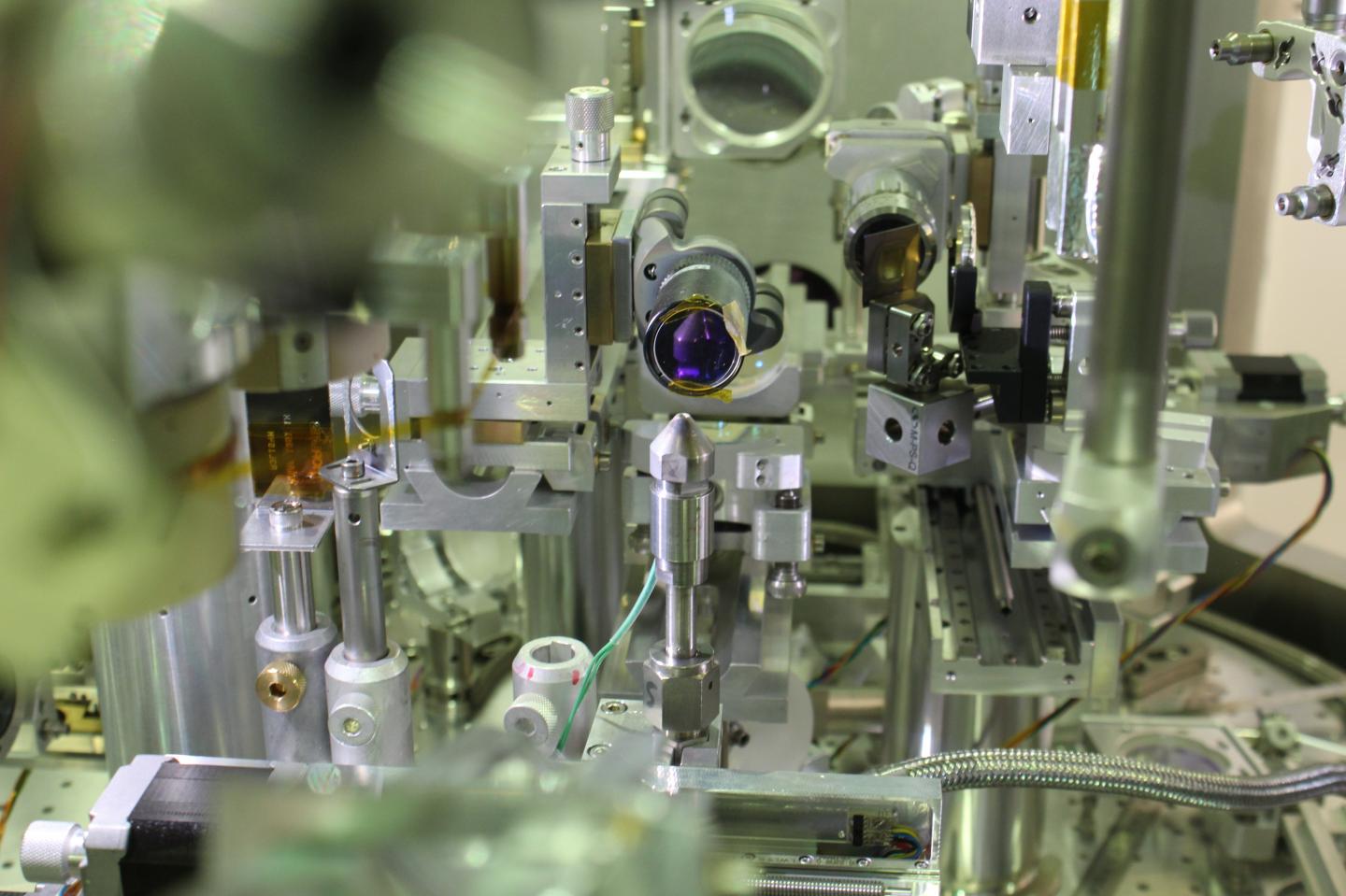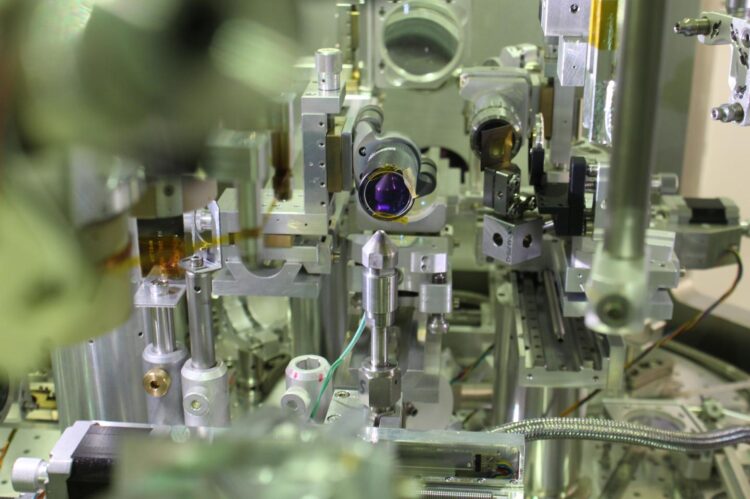Research team presents a new type of particle accelerator

Credit: Arie Irman
Since they are far more compact than today’s accelerators, which can be kilometers long, plasma accelerators are considered as a promising technology for the future. An international research group has now made significant progress in the further development of this approach: With two complementary experiments at the Helmholtz-Zentrum Dresden-Rossendorf (HZDR) and at the Ludwig-Maximilians-Universität Munich (LMU), the team was able to combine two different plasma technologies for the first time and build a novel hybrid accelerator. The concept could advance accelerator development and, in the long term, become the basis of highly brilliant X-ray sources for research and medicine, as the experts describe in the journal Nature Communications (DOI: 10.1038/s41467-021-23000-7).
In conventional particle accelerators, strong radio waves are guided into specially shaped metal tubes called resonators. The particles to be accelerated – which are often electrons – can ride these radio waves like surfers ride an ocean wave. But the potential of the technology is limited: Feeding too much radio wave power into the resonators creates a risk of electrical charges that can damage the component. This means that in order to bring particles to high energy levels, many resonators have to be connected in series, which makes today’s accelerators in many cases kilometers long.
That is why experts are eagerly working on an alternative: plasma acceleration. In principle, short and extremely powerful laser flashes fire into a plasma – an ionized state of matter consisting of negatively charged electrons and positively charged atomic cores. In this plasma, the laser pulse generates a strong alternating electric field, similar to the wake of a ship, which can accelerate electrons enormously over a very short distance. In theory, this means facilities can be built far more compact, shrinking an accelerator that is a hundred meters long today down to just a few meters. “This miniaturization is what makes the concept so attractive,” explains Arie Irman, a researcher at the HZDR Institute of Radiation Physics. “And we hope it will allow even small university laboratories to afford a powerful accelerator in the future.”
But there is yet another variant of plasma acceleration where the plasma is driven by near-light-speed electron bunches instead of powerful laser flashes. This method offers two advantages over laser-driven plasma acceleration: “In principle, it should be possible to achieve higher particle energies, and the accelerated electron beams should be easier to control,” explains HZDR physicist and primary author Thomas Kurz. “The drawback is that at the moment, we rely on large conventional accelerators to produce the electron bunches that are needed to drive the plasma.” FLASH at DESY in Hamburg, for instance, where such experiments take place, measures a good one hundred meters.
High-energy combination
This is precisely where the new project comes in. “We asked ourselves whether we could build a far more compact accelerator to drive the plasma wave,” says Thomas Heinemann of the University of Strathclyde in Scotland, who is also a primary author of the study. “Our idea was to replace this conventional facility with a laser-driven plasma accelerator.” To test the concept, the team designed a sophisticated experimental setup in which strong light flashes from HZDR’s laser facility DRACO hit a gas jet of helium and nitrogen, generating a bundled, fast electron beam via a plasma wave. This electron beam passes through a metal foil into the next segment, with the foil reflecting back the laser flashes.
In this next segment, the incoming electron beam encounters another gas, this time a mixture of hydrogen and helium, in which it can generate a new, second plasma wave, setting other electrons into turbo mode over a span of just a few millimeters – out shoots a high-energy particle beam. “In the process, we pre-ionize the plasma with an additional, weaker laser pulse,” Heinemann explains. “This makes the plasma acceleration with the driver beam far more effective.”
Turbo ignition: Almost to the speed of light within just one millimeter
The result: “Our hybrid accelerator measures less than a centimeter,” Kurz explains. “The beam-driven accelerator section uses just one millimeter of it to bring the electrons to nearly the speed of light.” Realistic simulations of the process show a remarkable gradient of the accelerating voltage in the process, corresponding to an increase of more than a thousand times when compared to a conventional accelerator. To underscore the significance of their findings, the researchers implemented this concept in a similar form at the ATLAS laser at LMU in Munich. However, the experts still have many challenges to overcome before this new technology can be used for applications.
In any case, the experts already have possible fields of application in mind: “Research groups that currently don’t have a suitable particle accelerator might be able to use and further develop this technology,” Arie Irman hopes. “And secondly, our hybrid accelerator could be the basis for what is called a free-electron laser.” Such FELs are considered extremely high-quality radiation sources, especially X-rays, for ultra-precise analyses of nanomaterials, biomolecules, or geological samples. Until now, these X-ray lasers required long and expensive conventional accelerators. The new plasma technology could make them much more compact and cost-effective – and perhaps also affordable for a regular university laboratory.
###
Publication:
T. Kurz, T. Heinemann, M. F. Gilljohann, Y. Y. Chang, J. P. Couperus Cabada?, A. Debus, O. Kononenko, R. Pausch, S. Schöbel, R. W. Assmann, M. Bussmann, H. Ding, J. Götzfried, A. Köhler, G. Raj, S. Schindler, K. Steiniger, O. Zarini, S. Corde, A. Döpp, B. Hidding, S. Karsch, U. Schramm, A. Martinez de la Ossa, A. Irman: Demonstration of a compact plasma accelerator powered by laser-accelerated electron beams, in Nature Communications, 2021 (DOI: 10.1038/s41467-021-23000-7)
For more information, contact:
Dr. Arie Irman
Institute of Radiation Physics
Phone: +49 351 260-3043 | email: [email protected]
Media contact:
Simon Schmitt | Head
Communications and Media Relations at HZDR
Phone: +49 351 260 3400 | Email: [email protected]
The Helmholtz-Zentrum Dresden-Rossendorf (HZDR) performs – as an independent German research center – research in the fields of energy, health, and matter. We focus on answering the following questions:
* How can energy and resources be utilized in an efficient, safe, and sustainable way?
* How can malignant tumors be more precisely visualized, characterized, and more effectively treated?
* How do matter and materials behave under the influence of strong fields and in smallest dimensions?
To help answer these research questions, HZDR operates large-scale facilities, which are also used by visiting researchers: the Ion Beam Center, the High-Magnetic Field Laboratory Dresden, and the ELBE Center for High-Power Radiation Sources.
HZDR is a member of the Helmholtz Association and has six sites (Dresden, Freiberg, Grenoble, Görlitz, Leipzig, Schenefeld near Hamburg) with almost 1,200 members of staff, of whom about 500 are scientists, including 170 Ph.D. candidates.
Media Contact
Simon Schmitt
[email protected]
Original Source
https:/
Related Journal Article
http://dx.





